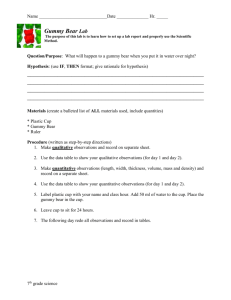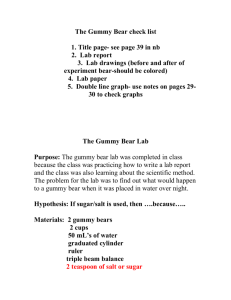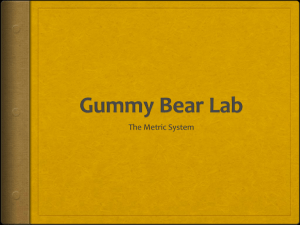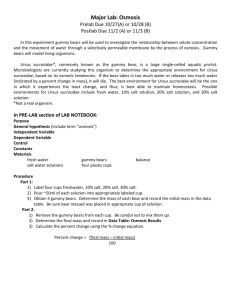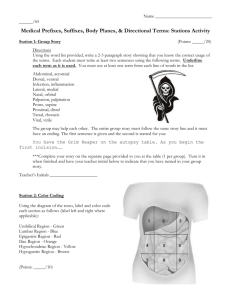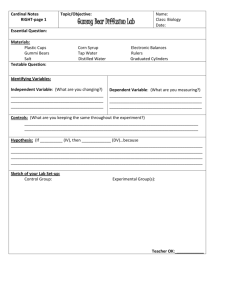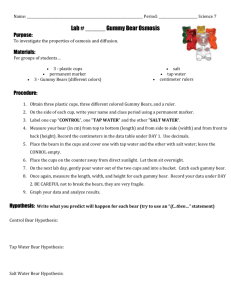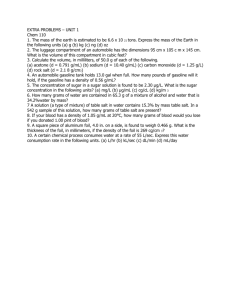Gummy Bear Challenge Lab Determine what percent salt solution
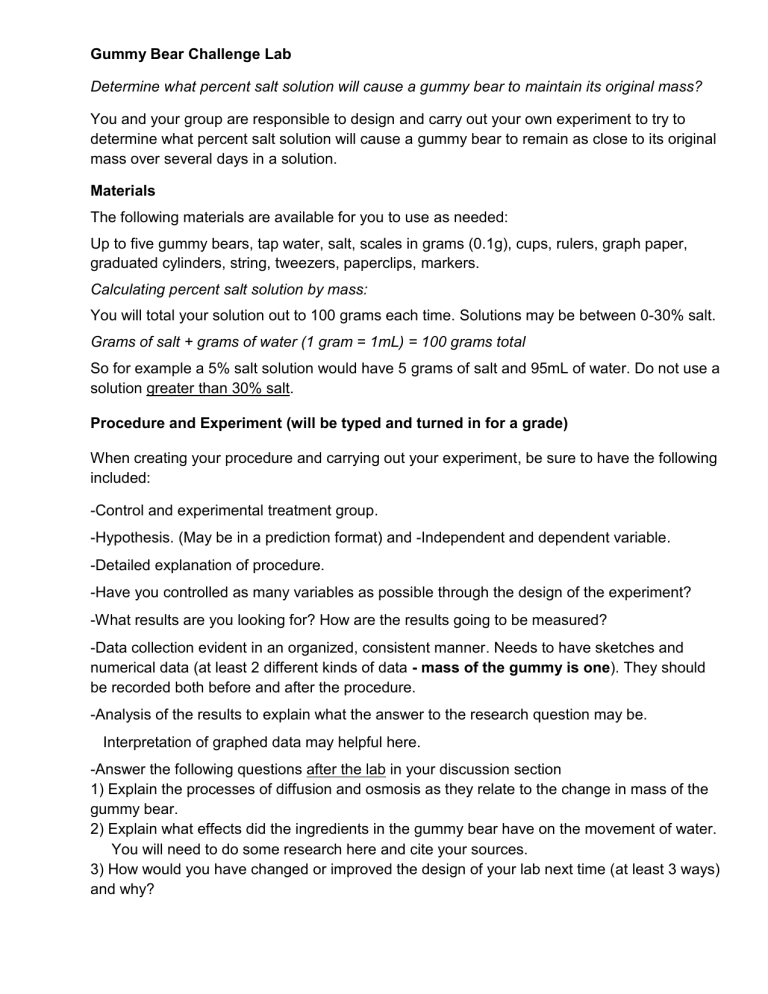
Gummy Bear Challenge Lab
Determine what percent salt solution will cause a gummy bear to maintain its original mass?
You and your group are responsible to design and carry out your own experiment to try to determine what percent salt solution will cause a gummy bear to remain as close to its original mass over several days in a solution.
Materials
The following materials are available for you to use as needed:
Up to five gummy bears, tap water, salt, scales in grams (0.1g), cups, rulers, graph paper, graduated cylinders, string, tweezers, paperclips, markers.
Calculating percent salt solution by mass:
You will total your solution out to 100 grams each time. Solutions may be between 0-30% salt.
Grams of salt + grams of water (1 gram = 1mL) = 100 grams total
So for example a 5% salt solution would have 5 grams of salt and 95mL of water. Do not use a solution greater than 30% salt.
Procedure and Experiment (will be typed and turned in for a grade)
When creating your procedure and carrying out your experiment, be sure to have the following included:
-Control and experimental treatment group.
-Hypothesis. (May be in a prediction format) and -Independent and dependent variable.
-Detailed explanation of procedure.
-Have you controlled as many variables as possible through the design of the experiment?
-What results are you looking for? How are the results going to be measured?
-Data collection evident in an organized, consistent manner. Needs to have sketches and numerical data (at least 2 different kinds of data - mass of the gummy is one ). They should be recorded both before and after the procedure.
-Analysis of the results to explain what the answer to the research question may be.
Interpretation of graphed data may helpful here.
-Answer the following questions after the lab in your discussion section
1) Explain the processes of diffusion and osmosis as they relate to the change in mass of the gummy bear.
2) Explain what effects did the ingredients in the gummy bear have on the movement of water.
You will need to do some research here and cite your sources.
3) How would you have changed or improved the design of your lab next time (at least 3 ways) and why?
Gummy Bear Lab Report - Overview
Scientists use an experiment to search for cause and effect relationships in nature. In other words, they design an experiment so that changes to one item cause something else to vary in a predictable way. These changing quantities are called variables , and an experiment usually has three kinds: independent, dependent, and controlled. In you lab report you will need to address all three variables.
Contents
Format / Title:
The report is to be typed, 1 ½ or double-spaced with a standard font size 12 - Times New Roman or Arial.
Margins are to be no more than 1” for each edge. The title should be clearly labeled at the top of the page. It should be descriptive enough to give the reader an idea what he or she will be reading.
Hypothesis: You will write a statement making a prediction on what you expect to see in your results. You need to use the If…then format. You will need to identify your dependent and independent variables in your hypothesis by underling them. An independent variable is the one that is changed by the scientist. In an experiment there is only one independent variable . The dependent variable changes in response to the change the scientist makes to the independent variable. The new value of the dependent variable is caused by and depends on the value of the independent variable. For example, if you open a faucet (the independent variable), the quantity of water flowing (dependent variable) changes in response--the water flow increases. The number of dependent variables in an experiment varies, but there is often more than one.
Controlled variables are quantities that a scientist wants to remain constant, and he must observe them as carefully as the dependent variables. For example, if we want to measure how much water flow increases when we open a faucet, it is important to make sure that the water pressure (the controlled variable) is held constant.
That's because both the water pressure and the opening of a faucet have an impact on how much water flows. If we change both of them at the same time, we can't be sure how much of the change in water flow is because of the faucet opening and how much because of the water pressure.
Materials: This is a simple list of laboratory equipment and other materials needed to perform the experiment. In this section you will identify any safety issues related to the equipment we are using.
Procedure: This is a summary of what steps were taken to carry out the experiment. It will need to be detailed enough so that another person could perform the experiment based on your description. This is where you would address any controlled variables during the experiment in carrying out the procedure.
Data & Results: Here you would include your raw data obtained during the lab. Results would include any calculations. This section can be represented using sketches, graphs, tables, or other diagrams.
Discussion: This is where you evaluate your hypothesis. Did your experiment support or refute your hypothesis and explain. Be honest here. Evaluate your data in light of what should happen. You need to address any problems with experimental design or any other problems you encountered; why did you get the data you did?
References: If you make a statement that is not common knowledge in a paper and doesn’t come from your results, cite the source in the text of your discussion. Make the statement and then write the name of the author and the year of the publication (Jones, 1988). Do not use numbers for citations. A reference sheet or works cited should also accompany the lab report.
